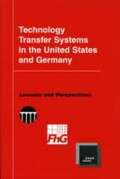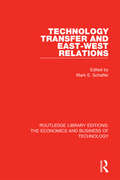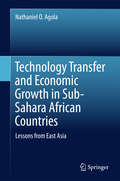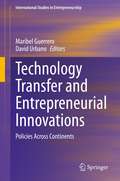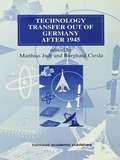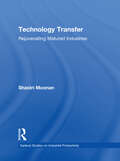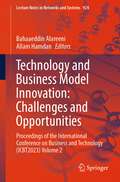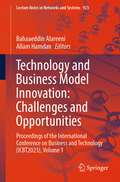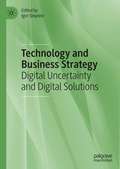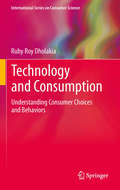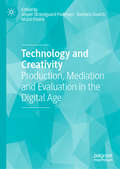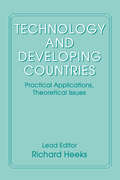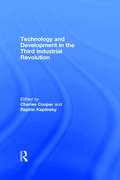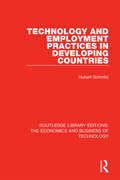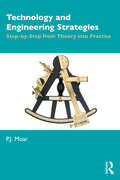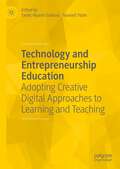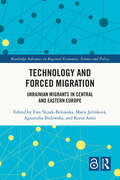- Table View
- List View
Technology Transfer Between the US, China and Taiwan: Moving Knowledge (Routledge Research on Taiwan Series)
by Douglas B. Fuller Murray A. RubinsteinExamining the flow of technical knowledge between the US, Taiwan and Mainland China over the last sixty-five years, this book shows that the technical knowledge that has moved between these states is vast and varied. It includes the invention and production of industrial goods, as well as knowledge of the patterns of corporate organization and management. Indeed, this diversity is reflected in the process itself, which is driven both by returning expatriates with knowledge acquired overseas and by successful government intervention in acquiring technology from multinational firms. Technology Transfer Between the US, China and Taiwan engages with the evolving debates on the merits, importance and feasibility of technology transfer in the process of economic development globally, and uses the example of Taiwan to show that multinational corporations can indeed play a positive role in economic development. Further, it reveals the underlying tension between international cooperation and nationalism which inevitably accompanies international exchanges, as well as the delicate balancing act required between knowledge acquisition and dangerous levels of dependency, and the beneficial role of the US in East Asia’s technological development. With contributors from disciplines ranging from history, geography, urban planning, sociology, political science and electrical engineering, this multi-disciplinary book will be of great interest to students and scholars working across a broad range of subjects including Taiwan studies, Chinese studies, economics, business studies and development studies.
Technology Transfer Systems in the United States and Germany: Lessons and Perspectives
by Proctor P. Reid H. Norman Abramson Jose Encarnacao Ulrich SchmochThis book explores major similarities and differences in the structure, conduct, and performance of the national technology transfer systems of Germany and the United States. It maps the technology transfer landscape in each country in detail, uses case studies to examine the dynamics of technology transfer in four major technology areas, and identifies areas and opportunities for further mutual learning between the two national systems.
Technology Transfer and East-West Relations (Routledge Library Editions: The Economics and Business of Technology #45)
by Mark E. SchafferOriginally published in 1985, in the deteriorating climate of East-West relations technology transfer became vitally important. The Eastern bloc desperately needed Western technology to assist in the development of the socialist economies, but a proposed US ban on the export of Western technology to the Siberian pipeline project led to increasing tension within the Western alliance abot the nature and scale of high technology that could be safely exported to the East. This book reviews the state of technology transfer to the East in the 1980s and considers the place of Western technology in the Eastern economies. It also discusses the strategic goals of Western technology embargoes. Many of the issues discussed remain pertinent today.
Technology Transfer and Economic Growth in Sub-Sahara African Countries
by Nathaniel O. AgolaThis book provides a pragmatic analytical model grounded on the solid idea that technologies and the accompanying implementation efforts only make sense if they are successfully deployed in markets. The analytical model also provides an exhaustive analysis of all critical variables at the global, regional and national levels, which contribute to failure or success of technology transfer efforts. The model is validated by an incisive analysis of technology transfer experiences of Japan, Korea, Singapore, Taiwan (province of China), and Malaysia. While this book finds that these East Asian countries have had both diverging and converging models, and experiences with technology transfer, the enduring and fundamental aspects of technology transfer in specific industrial sectors and economic growth in these countries is then used to draw lessons for African countries. This book therefore is a timely and compelling piece of research work that provides valuable answers to the increasingly urgent question of how African countries can industrialize through technology transfer to meet their economic development and growth ideals.
Technology Transfer and Entrepreneurial Innovations: Policies Across Continents (International Studies in Entrepreneurship #51)
by David Urbano Maribel GuerreroEvidence suggests that economies with technology transfer initiatives provide a better supply of high-quality jobs and tend to be characterized by entrepreneurs with higher innovation contributions. This book explores the effectiveness of technology transfer policies and legislation on entrepreneurial innovation in a non-US context. It analyses the theoretical, empirical and managerial implications behind the success of technology transfer polices and legislations in stimulating entrepreneurial innovation; analyses which other contextual condition (e.g., culture) are necessary for successful implementation; and explores the extent and level of replication of US policies (e.g., Bayh-Dole Act, Small Business Innovation Research [SBIR] program) in other national and regional systems. In addition, this book looks at the effect technology transfer policies have on the adoption of open innovation and open science.
Technology Transfer at U.S. Universities
by Josh Lerner David Kiron Richard G. HamermeshTechnology transfer from U.S. universities to industry has increased dramatically in the last 25 years. Reviews the history of technology transfer with particular emphasis on the Bayh-Dole Act of 1980. It then examines how universities responded to Bayh-Dole, the growth of technology transfer offices, and compares how three different universities (MIT, Stanford, and Harvard) approach technology transfer. Provides an overview of the technology transfer process and issues around current practices.
Technology Transfer at a Defense Contractor
by Linda A. Hill Jaan EliasAt a time of great changes in the corporate environment, Larry Yoshino, a design lab manager at Parsons Controls Corp., faces a delay in a costly defense project due to the inability of one of his subordinates to gain the cooperation of engineers at Parsons' manufacturing plant. The physical distance between the plants, different functions, and unequal power relations feed the conflict, forcing Yoshino to reexamine his role. The case promotes discussion of 1) friction between design and manufacturing, 2) managing self-managing professionals, and 3) changing behaviors to reflect new competitive situations.
Technology Transfer in a Global Economy
by David B. Audretsch Albert N. Link Erik E. Lehmann Alexander StarneckerTechnology transfer--the process of sharing and disseminating knowledge, skills, scientific discoveries, production methods, and other innovations among universities, government agencies, private firms, and other institutions--is one of the major challenges of societies operating in the global economy. This volume offers state-of-the-art insights on the dynamics of technology transfer, emerging from the annual meeting of the Technology Transfer Society in 2011 in Augsburg, Germany. It showcases theoretical and empirical analyses from participants across the technology transfer spectrum, representing academic, educational, policymaking, and commercial perspectives. The volume features case studies of industries and institutions in Europe, the United States, and Australasia, explored through a variety of methodological approaches, and providing unique contributions to our understanding of how and why technology transfer is shaped and affected by different institutional settings, with implications for policy and business decision making.
Technology Transfer out of Germany after 1945 (Routledge Studies in the History of Science, Technology and Medicine #2)
by Burghard Ciesla Matthias JudtTechnology Transfer Out of Germany studies the movement of technology and scientists between East Germany and the Soviet Union, and West Germany and the Western Allies, using documented examples and case studies, and asks whether the confiscation of documents, equipment and scientists can really be considered to be a form of 'intellectual reparation.'
Technology Transfer: Rejuvenating Matured Industries (Garland Studies on Industrial Productivity)
by Shastri MoonanThis study focuses on technology transfer in the steel mini-mill industry. It identifies two central issues: how capacity is built and how demand is sustained, developing a three-dimensional perspective to bring into sharp focus the desirability and necessity of technology transfer. The three-dimensional perspective focuses on the changes in the marketplace for flat steel sheets, the responsiveness and sensitivity to these market changes, and applying the best available technology to obtain a high quality product. Prior to this study, technology transfer has been examined in a bivariate relationship, namely, how technology transfer contributed to the development process in developing countries and Newly Industrialized Countries (NICs). The framework formulated in this study showed that Japan was lagging behind all the steel-producing countries because, like the NICs, it imported the physical and organizational technologies that fostered its prosperity. Based on primary and secondary research, this study revealed that high levels of operational efficiency and sophisticated product quality were achieved through continuous improvement culminating in Computer Integrated Manufacturing (CIM) consisting of Real Time Process Control. On the other hand, the research also revealed that China based the improvement of its steel industry on self-reliance combined with judicious selection of foreign collaboration. The theoretical underpinnings of the crucial issues in this study led to the development of an interactive model of technology transfer based upon stock and flow variables.
Technology and American Economic Growth
by Nathan RosenbergIn 1982, Vaclav Smil turned upside down traditional perceptions of China as a green paradise in "The Bad Earth". Updating and expanding its basic arguments and perceptions, this volume is an inquiry into the fundamental factors, needs, prospects, and limits of modern Chinese society.
Technology and Business Model Innovation: Proceedings of the International Conference on Business and Technology (ICBT2023) Volume 2 (Lecture Notes in Networks and Systems #924)
by Allam Hamdan Bahaaeddin AlareeniThis book proceedings addresses a crucial gap in understanding the impact of technology on Business Model Innovation (BMI). It emphasizes the need for further research to explore the intricate relationship between technology and BMI, focusing on opportunities and challenges. By delving into how technology influences emerging business model innovations and enhances operational efficiency, the publication aims to advance knowledge. Inviting diverse research methods, it sheds light on various ideas within the technology and BMI realm. Tailored for students, scholars, professionals, and policymakers, this book contributes to the evolving field of BMI and technology.
Technology and Business Model Innovation: Proceedings of the International Conference on Business and Technology (ICBT2023), Volume 1 (Lecture Notes in Networks and Systems #923)
by Allam Hamdan Bahaaeddin AlareeniThis book proceedings addresses a crucial gap in understanding the impact of technology on Business Model Innovation (BMI). It emphasizes the need for further research to explore the intricate relationship between technology and BMI, focusing on opportunities and challenges. By delving into how technology influences emerging business model innovations and enhances operational efficiency, the publication aims to advance knowledge. Inviting diverse research methods, it sheds light on various ideas within the technology and BMI realm. Tailored for students, scholars, professionals, and policymakers, this book contributes to the evolving field of BMI and technology.
Technology and Business Strategy: Digital Uncertainty and Digital Solutions
by Igor StepnovThis book examines how new technologies have transformed global markets, as well as global business strategy. It explores how digitalization, artificial intelligence, virtual reality, and other changes in technology have led both to new opportunities but also to increased uncertainty within both business and legislature.By pulling together academics from Russia, China, France, Hungary, Azerbaijan, Tajikistan and other countries, this book provides a truly international perspective on the impact of new technologies across areas including smart cities, corporate governance, EU legislation and logistical enterprise. It will be valuable reading for academics interested in digitization, digital business, digital entrepreneurship and the way that technological change has informed strategy.
Technology and Consumption
by Ruby Roy DholakiaTechnology and Household Consumption is a comprehensive text that provides insights into technology's impact on consumer behavior and the household environment. Consumption and consumer behavior has become a very important subject of study that is now covered in many disciplines including family economics, culture studies, and feminist/women studies. In the first section, this book provides a historical perspective on how consumer behaviors have changed because of technology and how technology itself has changed. Data on ownership and expenditures is detailed in describing the penetration of technology in the household and changes over time. In the examination of demographics and social changes, an emphasis is placed on women and children. As it is important to understand the entry paths and factors that influence them, the book also introduces a research framework to understanding the adoption and utilization of household technologies. In the second section, the book examines specific household technologies and consumption experiences including shopping choices and behaviors, entertainment outlets and availability, communications technologies, and working at home. The book concludes with a section on the relationships between marketers and consumers.
Technology and Creativity: Production, Mediation and Evaluation in the Digital Age
by Jesper Strandgaard Pedersen Mukti Khaire Barbara SlavichThis edited book explores the digital challenge for cultural-creative organizations and industries, and its impact on production, meaning-making, consumption and valuation of cultural-creative products and experiences. Discussing digital changes such as user-generated content, social media, business model innovation and product development, the chapters challenge deep-seated definitions of creative individuals, organizations and industries, offering insights into how this creative aspect is argued and legitimized. Placing an emphasis on research that deals with the digital challenge, this collection theorizes its significance for the nature and dynamics of creative industries as well as its impact on the mediation of experiences and the creation and consumption of cultural-creative products.
Technology and Developing Countries: Practical Applications, Theoretical Issues
by Chris Lewis Richard Heeks Mozammel Huq Prabhakara Bhatt Ahmed ShibliThe relationship between technology and development is explored by economists, policy analysts and other experts. The adoption of technology is studied in five main areas agriculture, energy, infrastructure, the introduction of technology and the success and constraints of technological diffusion as a whole. This volume also examines the technology transfer between North and South from a perspective of training, environmental impact and aid dependency. The emphasis is not placed simply on finding problems, but ways forward are examined. By bringing together both practical and intellectual analysis, this collection signposts future directions in the technologydevelopment relationship.
Technology and Development in the Third Industrial Revolution
by Raphael Kaplinsky Charles CooperFirst published in 1989, Technology and Development in the Third Industrial Revolution is a significant contribution to history.
Technology and Employment Practices in Developing Countries (Routledge Library Editions: The Economics and Business of Technology #47)
by Hubert SchmitzOriginally published in 1985, this book analyses the extent and way in which technological change determines the utilisation of labour in less developed economies. The book compares firms which are technologically very advanced with firms which use less sophisticated machinery and equipment, and analyses how technology shapes their demand for labour. It is concerned with the impact of technological change on the utilisation of labour in terms of number of jobs, recruitment, training, skill requirements, labour turnover, wages and internal mobility; it also investigates the impact on the utilisation of external labour in the form of subcontracting of small producers and employment of outworkers.
Technology and Engineering Strategies: Step-by-Step from Theory into Practice
by P.J. MoarThis pioneering book is the first-ever practical guide to developing and communicating technology and engineering strategies.It presents a unique step-by-step method for creating robust, evidence-based strategy, known as the Five Dimensions Process (or 5DP). The book also introduces a host of original insights, including a new theory of technology, a novel approach to product innovation, and groundbreaking contributions to our understanding of technological risk. It describes many easy-to-use tools, both new and established, for supporting activities such as solution design, system monitoring, risk identification, project management, the development of personnel, and ethical decision making. The book brims with strategic and tactical advice on such topics as university collaboration, technical compatibility, data utilisation, product design, project cancellations, outsourcing, knowledge management, and risk mitigation.It is essential reading for technologists and engineers across all disciplines, technology and engineering leaders, and professional strategy consultants.
Technology and Entrepreneurship Education: Adopting Creative Digital Approaches to Learning and Teaching
by Denis Hyams-Ssekasi Naveed YasinThis contemporary book offers valuable insights on digital technology and entrepreneurship education, highlighting the importance of adopting creative digital approaches to learning and teaching. It raises the questions as to whether the current approaches utilised to convey entrepreneurial knowledge are adequate enough when preparing graduates for prospective careers. The book directly addresses the need for effective practices in teaching and reinforces the rising interest and resilience in entrepreneurship. Comprising a number of distinct chapters that illuminate digitally assisted teaching methods that are used in practice to champion student engagement when learning enterprise and entrepreneurship. The contemporary practices allude to the notion that the adoption of simulations and game-based learning increases student’ comprehension, helps in retention of knowledge, and is an excellent way to introduce new content. With the substantial challenges caused by the global pandemic this book is a vital resource at a time when blended learning is the new norm and mode of instruction in Higher Education. It is ideal for researchers, instructors and students with a keen interest in game-based approaches, as it encourages application and outlook towards entrepreneurship education.
Technology and Finance
by Anna Ilyina Roberto SamaniegoA report from the International Monetary Fund.
Technology and Finance: Challenges for Financial Markets, Business Strategies and Policy Makers (Routledge International Studies In Money And Banking Ser. #Vol. 17)
by Andy Mullineux Morten Balling Frank LiermanTechnology and Finance analyses the dramatic implications of technology for today's financial sector, for productivity growth and for monetary policy. A wide range of financial market activities are now technology driven; technology is also crucial in retail, private and corporate banking, and it has lowered entry barriers to the sector. New partic
Technology and Forced Migration: Ukrainian Migrants in Central and Eastern Europe (Routledge Advances in Regional Economics, Science and Policy)
by Ewa Ślęzak-Belowska Marie Jelínková Agnieszka Bielewska Karin AmitThe Russian aggression on Ukraine has drastically altered the migration situation in Central and Eastern Europe (CEE), drawing international attention. Despite numerous global studies on individuals seeking refuge, CEE remains underresearched. This book details the recent, lesser-known experiences of countless forced migrants who arrived there.Given the pivotal role of information and telecommunication technologies (ICTs) for both migrants and host societies, the book explores the intersection of ICTs and forced migration. With this in mind, the book focuses on Poland, Czechia, Slovakia, and Hungary, and uses comprehensive research and robust qualitative methods to demonstrate how these countries are emerging as New Immigration Destinations and handling the influx of Ukrainians. Contributions from economists, sociologists, and political scientists provide a thorough examination of how Ukrainian forced migrants navigate their lives using modern technologies, as well as their impact on these technologies.Essential reading for academics, policymakers, and professionals in the fields of migration studies, digital governance, and European affairs, this book uniquely highlights the vital role of ICTs in migration decisions, journeys, settlement, and integration. It provides a balanced mix of theoretical analysis and practical insights, helping readers comprehend the interplay between ICTs and migration. Readers will obtain a better understanding of the challenges and opportunities that digital technologies bring in facilitating and regulating forced migration in this part of Europe.
Technology and Globalisation: Networks of Experts in World History (Palgrave Studies in Economic History)
by Lino Camprubí David PretelThis book examines the role of experts and expertise in the dynamics of globalisation since the mid-nineteenth century. It shows how engineers, scientists and other experts have acted as globalising agents, providing many of the materials and institutional means for world economic and technical integration. Focusing on the study of international connections, Technology and Globalisation illustrates how expert practices have shaped the political economies of interacting countries, entire regions and the world economy. This title brings together a range of approaches and topics across different regions, transcending nationally-bounded historical narratives. Each chapter deals with a particular topic that places expert networks at the centre of the history of globalisation. The contributors concentrate on central themes including intellectual property rights, technology transfer, tropical science, energy production, large technological projects, technical standards and colonial infrastructures. Many also consider methodological, theoretical and conceptual issues.

